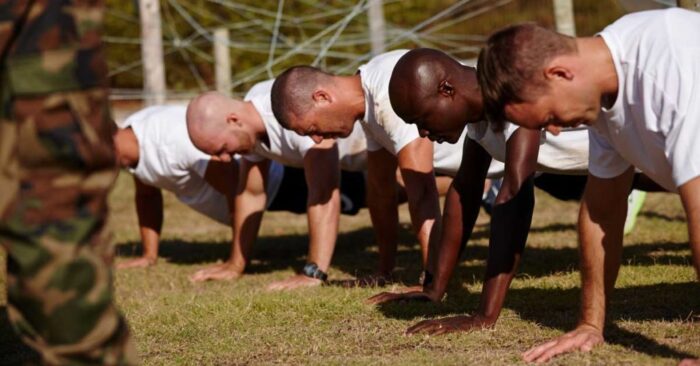The Army Combat Fitness Test (ACFT) serves as the physical fitness assessment for the U.S. Army. It consists of six events that challenge soldiers across broad fitness domains: strength, endurance, power, speed, coordination, flexibility, balance, and agility. The ACFT aims to enhance soldiers’ readiness for the physical challenges of combat. In this article we talk about How to Adapt ACFT Training for Different Fitness Levels.
However, the increased difficulty of the ACFT poses challenges, especially for soldiers who are new to fitness or returning from injury. The good news is that the ACFT can be adapted for different fitness levels. With some modifications to the exercises, volume, and progressions, soldiers at any starting point can improve their ACFT performance.
Assess Your Starting Fitness Level

The first step is to realistically assess your current fitness to determine appropriate ACFT modifications. Consider factors like:
- Current aerobic endurance
- Muscular strength and endurance
- Mobility, flexibility, and movement quality
- Body composition
Be honest about your capacities so you can tailor the training to your needs. Those new to working out will need to take things slower than seasoned athletes transitioning to the ACFT.
ACFT Modifications for Beginners
If you have limited fitness experience, consider the following ACFT modifications:
Deadlift: Use lighter weights like 95 or 135 lbs. Focus on perfecting form and technique before adding weight.
Standing Power Throw: Use a lighter medicine ball, like the 10 or 15 lb ball. Focus on coordination and safe movement patterns.
Hand Release Push Ups: Elevate hands on a box or bench to decrease resistance. Only perform to your capable range of motion.
Sprint Drag Carry: Walk instead of sprint during the run portions. Use lighter weights on the drags and carries, like 65 lbs. Use two hands instead of one where applicable.
Leg Tucks: Scale the movement by doing hanging knee raises, eccentric leg lowers, or flexed arm hangs before building up to full leg tucks.
Two Mile Run: Run at an easy, conversational pace. Run/walk intervals are also fine as you build aerobic endurance.
ACFT Modifications for Intermediate Fitness
If you have a baseline level of fitness, consider these ACFT modifications:
Deadlift: Use 135 lbs or 185 lbs to refine technique. Do higher rep sets (8-10 reps) with lighter weights before increasing load.
Standing Power Throw: Use a 10 or 15 lb medicine ball. Work on forceful triple extension and follow through using your entire body.
Hand Release Push Ups: Elevate feet on a box instead of hands to increase resistance. Do push ups to failure using perfect form.
Sprint Drag Carry: Jog instead of sprint during the run portions. Use lighter weights like 95 lbs on the carries. Switch hands when fatigued.
Leg Tucks: Use eccentric leg lowers to build strength in the pull up position. Do isometric holds at the top of the leg tuck.
Two Mile Run: Run at a challenging but maintainable pace. Run entire distance but take short walking breaks as needed.
ACFT Modifications for Advanced Fitness
Soldiers with higher pre-existing fitness can make these ACFT prep modifications:
Deadlift: Use heavier weight like 225 lbs or 265 lbs for lower rep sets (3-5 reps) to build maximal strength. Focus on exploding fast.
Standing Power Throw: Use the heavier medicine balls, like 20 lb or 30 lb. Throw for maximal distance on every rep. Ask someone to catch the ball and toss it back to you.
Hand Release Push Ups: Elevate the feet to increase resistance. Do push ups on unstable surfaces to create a balance challenge. Target muscular endurance with high rep sets.
Sprint Drag Carry: Sprint as fast as possible on the run portions. Go heavy on carriers, using 140 lbs or more. If the weight feels easy to carry, you’re likely not going heavy enough.
Leg Tucks: Wear a weight vest or hold a dumbbell between your feet for added resistance. Do maximal reps on each set.
Two Mile Run: Run at your fastest maintainable pace. Sprint the last 1⁄4 mile. Have someone pace you.
Customize Your ACFT Training Plan
The above progressions are general guidelines. To create an optimal ACFT training plan, tailor the modifications to your individual needs and abilities. Consider working with a certified trainer, especially if you are returning from injury.
The key is to scale the difficulty up or down so you can practice and progressively develop competence in each test event. Avoid overexertion but also challenge yourself appropriately over time as your fitness improves.
Use active recovery, proper nutrition, and adequate sleep to support muscular adaptation between ACFT workouts. Listen to your body so you can train productively over the long term.
The ACFT requires broad, functional fitness best built through periodized, multi-modal training. Fortunately the test can be adapted for soldiers of all backgrounds and ability levels so everyone has an opportunity to reach their fitness potential. Approach the training intelligently and patiently and you’ll see excellent ACFT results. I sincerely hope you find this “How to Adapt ACFT Training for Different Fitness Levels” article helpful.

Leave a Reply